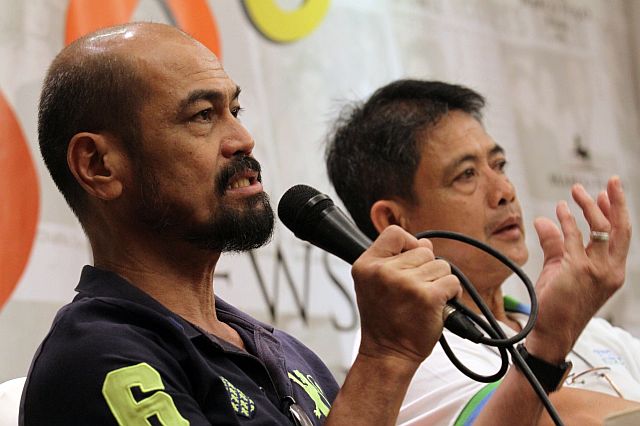
Engineers Lemuel Canastra (left) and Raul Tabasa of MCWD announce that the water supply in Cebu is now almost back to normal. (CDN PHOTO/JUNJIE MENDOZA)
As Cebu has been experiencing light, moderate to occasionally heavy rains, the island’s water supply is now almost back to normal.
According to Raul Tabasa, Metropolitan Cebu Water District (MCWD) Engineering department manager, the water supply in Metro Cebu now stood at 90 percent.
Tabasa explained that as of last week, the total water supply production of MCWD has reached 220,000 cubic meters per day, which is just 5,000 cu.m. shy of the usual daily water production of 225,000 cu.m. before the El Niño hit the country this year.
Water supply production in Metro Cebu went as low as 190,000 cu.m. per day about a month ago with major water sources such as Jaclupan Dam producing only 7,000 cubic meters daily, which was short from its usual 33,000 cubic meters daily production. With the rainy season at hand, Jaclupan Dam has now produced higher water supply, with the latest being recorded at 29,000 cu.m. per day.
Lemuel Canastra, officer-in-charge of the Environment and Water Resources Department of MCWD, said that using alternative water sources is necessary because ground water sources in Cebu have already been fully utilized.
In order to cope with the future water demand, Canastra said that surface water such as rivers and watersheds of MCWD’s service areas in Cebu City, Compostela, Liloan, Consolacion and Talisay City must be used through the water-impounding facilities.
Canastra said water stored in these water-impounding facilities or dams would augment the water supply during summer or hot weather conditions such as El Niño.
According to Tabasa, water-impounding facilities cannot altogether control the surge of floodwaters brought about by the heavy rains, but it can alleviate its effects up to a certain point.
“Kun ang baha gisundan pa gyud ug baha, puno ang dam so ang dam mo-spill gyud. Pero kun ang baha gisundan ug taas-taas nga panahon nga way kusog nga uwan, ma-lower ang water level sa dam then it alleviate the flow of the river. So from time to time, depende sa situation, maka-help siya but di gyud si maka-control sa baha (If the flood is followed by another flood, the dam would likely spill. But if the flood is followed by a long period of no rain, it would lower the dam’s water level and then alleviate the flow of the river,” Tabasa said.
Tabasa acknowledged that MCWD encountered setbacks in the development of dam projects especially when it comes to funding. But he said they were addressing a pending request to Jica (Japan International Cooperation Agency) to sponsor a feasibility study regarding the development of dams within their service area, such as the one in Buhisan.
Tabasa said a meeting would be held next month to discuss the funding for the development of these dam projects.